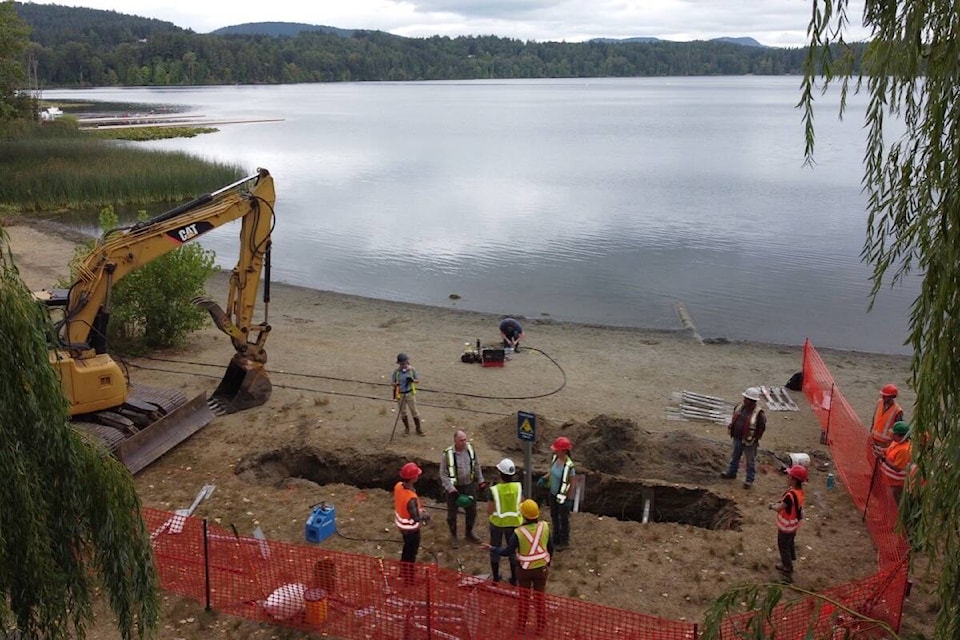The Bดฮิชนูอ๘อ๘ึทexciting new discoveryBดฮิชนูอ๘อ๘ึท of a fault line running across the Saanich Peninsula can build on hazard models and remind residents to be ready for a different kind of earthquake.
Focus in the region is frequently on the hazard of mega-thrust earthquakes, said Theron Finley, an earthquake geologist and University of Victoria PhD candidate who is among the authors of the research published Dec. 6.
A secondary hazard lies in crustal faults, such as the newly identified XEOLXELEK-Elk Lake fault. While smaller they tend to be a lot shallower and in this case far closer to urban centres, posing a hazard.
Bดฮิชนูอ๘อ๘ึทOur research group focuses on looking for faults of this nature and thereBดฮิชนูอ๘อ๘ึทs not been a lot of work done on this,Bดฮิชนูอ๘อ๘ึท Finley said.
The report comes nearly two years after they physically investigated a segment of the fault with a trench near the shores of Elk Lake (XEOLXELEK).
First the team had to find the potential for a fault, primarily using lidar data.
The region isnBดฮิชนูอ๘อ๘ึทt unexposed to the low-flying helicopters sending laser pulses to map the landscape. After digitally removing trees and buildings theyBดฮิชนูอ๘อ๘ึทre left with a detailed bare earth surface topographical map to scour for scarps Bดฮิชนูอ๘อ๘ึท ruptures on the surface of the earth that could indicate a fault.
Once found, to study the earthquake history of the fault, the team used electrical resistivity surveying Bดฮิชนูอ๘อ๘ึท using currents to map the distribution of sediment in the subsurface Bดฮิชนูอ๘อ๘ึท and excavated a trench across the scarp to examine the sediment.
READ ALSO:
Like an archaeological dig but looking for ancient earthquakes, Theron explained.
The work revealed a single large earthquake, of magnitude 6.1 to 7.6, likely occurred there about 4,700 to 2,300 years ago.
Bดฮิชนูอ๘อ๘ึทWe obtain that by taking samples of organic material from sedimentary layers observed in the trench we dug and radiocarbon dating those,Bดฮิชนูอ๘อ๘ึท he explained.
They also use measurements of how it moved and compare those to a catalogue of modern earthquake events to determine a range of magnitude.
Bดฮิชนูอ๘อ๘ึทItBดฮิชนูอ๘อ๘ึทs an imprecise science because nothing in nature is perfect, thatBดฮิชนูอ๘อ๘ึทs why we have a big range in estimate on what it potentially could have been,Bดฮิชนูอ๘อ๘ึท Finley said.
The trench excavation happened in 2021 and the paper published just recently after rigorous peer review, but theyBดฮิชนูอ๘อ๘ึทre far from finished.
Bดฮิชนูอ๘อ๘ึทWe do still have a lot of ongoing work on the Island looking for similar features elsewhere,Bดฮิชนูอ๘อ๘ึท Finley said. Bดฮิชนูอ๘อ๘ึทWe suspect we will continue to find more as more lidar data is available.Bดฮิชนูอ๘อ๘ึท
ItBดฮิชนูอ๘อ๘ึทs an exciting new discovery that helps them better understand earthquake hazards in the region, said John Cassidy an earthquake seismologist with National Resources Canada. This work can only add to the understanding of earthquake potency and potential.
Bดฮิชนูอ๘อ๘ึทWeBดฮิชนูอ๘อ๘ึทre always trying to extend our earthquake history and thatBดฮิชนูอ๘อ๘ึทs exactly what this study does,Bดฮิชนูอ๘อ๘ึท he said. Bดฮิชนูอ๘อ๘ึทIt doesnBดฮิชนูอ๘อ๘ึทt tell us there will be another earthquake on this fault Bดฮิชนูอ๘อ๘ึทฆ but it does help us understand the history and it will help guide future research.Bดฮิชนูอ๘อ๘ึท
READ ALSO:
Large crustal earthquakes have occurred here and are included in the hazard model already, Cassidy said, citing two in the magnitude 7 range Bดฮิชนูอ๘อ๘ึท in December 1918 near the west coast of Vancouver Island and the June 1946 earthquake with a mid-Island epicentre.
Bดฮิชนูอ๘อ๘ึทThe trick is we donBดฮิชนูอ๘อ๘ึทt know exactly where they occur. When we find structures like this one it helps Bดฮิชนูอ๘อ๘ึทฆ itBดฮิชนูอ๘อ๘ึทs really exciting,Bดฮิชนูอ๘อ๘ึท Cassidy said.
Bดฮิชนูอ๘อ๘ึทThis shouldnBดฮิชนูอ๘อ๘ึทt be frightening to people. ItBดฮิชนูอ๘อ๘ึทs always been there and now we know about it and that there was an earthquake Bดฮิชนูอ๘อ๘ึทฆ it will help us to improve our hazard maps. It will help us to better understand and be better prepared.Bดฮิชนูอ๘อ๘ึท
Previous modelling shows a future earthquake similar to the one the team documented could cause major damage in Greater Victoria.
Bดฮิชนูอ๘อ๘ึทThere have been loss estimates done for similar sort of event striking Victoria on a similar shallow fault like this,Bดฮิชนูอ๘อ๘ึท Finley said.
A magnitude 7.3 on a fault like this in such close proximity to the city could cause about 1,000 deaths and 7,000 building collapses with more than $20 billion in economic hit.
READ ALSO:
Bดฮิชนูอ๘อ๘ึทThe likelihood of this happening in the next, for example, 100 years, is probably lower than the Cascadia thrust Bดฮิชนูอ๘อ๘ึทฆ but it does add one more fault that could cause damaging shaking to our portfolio of faults that could cause a problem,Bดฮิชนูอ๘อ๘ึท he said. Bดฮิชนูอ๘อ๘ึทI think we want to take it as a reminder to both increase our own personal resilience.Bดฮิชนูอ๘อ๘ึท
In a place where we rarely feel any shaking, even with the myriad tiny earthquakes that constantly happen, it serves as another reminder to prepare or revisit things like earthquake plans and emergency preparedness kits.
Bดฮิชนูอ๘อ๘ึทPeople forget. We see rushes of people to the emergency preparedness stores when thereBดฮิชนูอ๘อ๘ึทs a small shake because people feel under-prepared. Hopefully even news of this discovery is motive for people to get out and prepared,Bดฮิชนูอ๘อ๘ึท Finley said. Bดฮิชนูอ๘อ๘ึทOn a more systemic level we need to really be taking seriously the work required to strengthen our buildings and protect human life.Bดฮิชนูอ๘อ๘ึท
Find the article.



